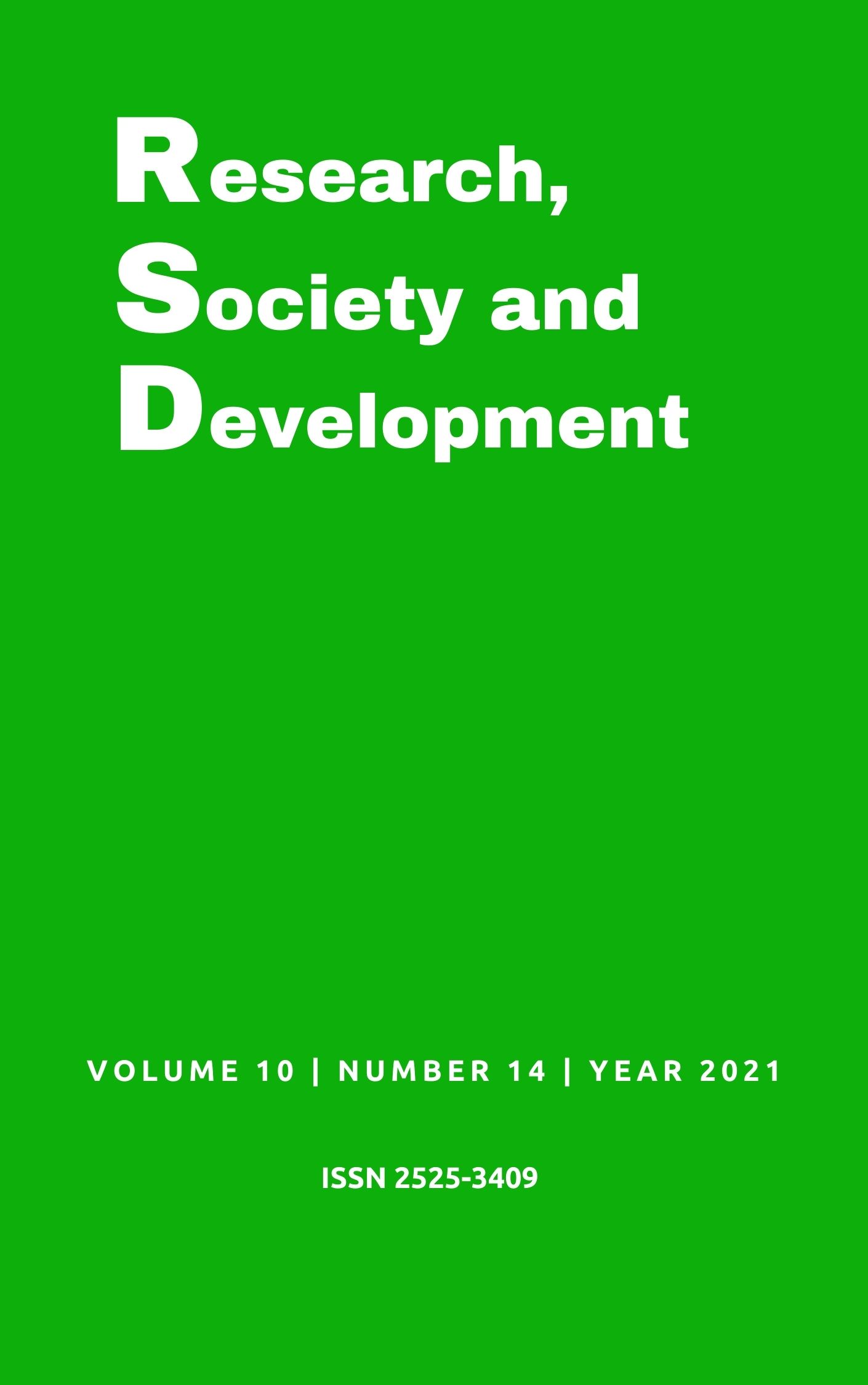Multiplication of semi-hard blueberry minicuttings using different substrates
DOI:
https://doi.org/10.33448/rsd-v10i14.21894Keywords:
Cultivars; Budding; Rooting; Vaccinium spp.Abstract
The increasing search of the population, in recent years, for healthier products, made this study viable, regarding the evaluation of the following variables: proportion of rooted cuttings, amount of sprouting, number of roots per cutting, average length of roots, unrooted cuttings with callus and proportion of germinated cuttings. The research was carried out in a greenhouse of the Brazilian Agricultural Research Corporation, located in the municipality of Pelotas, in the state of Rio Grande do Sul. The woody mini cuttings evaluated were blueberry, Vaccinium spp, with two cultivars, Bluecrisp and to O'Neal. In a polystyrene tray, containing 72 cells, with 4 repetitions, the following substrates were used: vermiculite, sand, peat, carbonized rice husk, sawdust and Carolina Soil - substrate for commercial use -, in each of the repetitions twelve minis were used. stakes, totaling 48 mini stakes evaluated. The evaluation was carried out during a period of 90 days, and every 15 days the shoots were evaluated and at the end of this period, the evaluation of their roots was also carried out.
References
Coradi, P. C., Vasconcelos, M. B., Dutra, A. D., Carvalho, G. C., Luz, M. L., & Luz, C. (Dezembro de 2018). Capítulo 44 - Processamento de pequenas frutas: amora e mirtilo. ReserchGate. https://www.researchgate.net/publication/330967705
Dini, M., Oliveira, Í. P., Mello-Farias, P., & Franzon, R. C. (2016). Crescimento inicial de Seedlings de mirtileiros com substratos e fertilizante organomineral. VII Encontro sobre Pequenas Frutas e Frutas do Mercosul. Fonte: https://www.alice.cnptia.embrapa.br/bitstream/d oc/1093376/1/RodrigoFranzonAnaisPequenasFrutas2016web.pdf
Fonseca, L. L da, & Oliveira, P. B de. (2007). A planta de mirtilo: Morfologia e fisiologia. INRB.
Gaspar, F. A. A. (2017). Identificação e quantificação de hidratos de carbono nas raízes de mirtilo e framboesa. 98 f. Dissertação (Mestrado) - Curso de Agronomia, Universidade de Lisboa.
Guedes, M. N. S., Pio, R., Maro, L. A. C., Lage, F. F., Abreu, C. M. P., & Sazc, A. A (2017). Antioxidant activity and total phenol content of blackberries cultivated in a highland tropical climate. Acta Scientiarum, 39(1), 43-48.
Hartmann, H., & Kester, D. (1990). Propagación de plantas - Principios y prácticas. México : Compañia Editorial Continental S.A.
Higuchi, M. T., Ribeiro, L. T., Aguiar, A. C., Zeffa, D. M., Roberto, S. R., & Koyama, R. (2021). Methods of application of indolebutyric acid and basal lesion on ‘Woodard’ blueberry cuttings in different seasons. Revista Brasileira de Fruticultura. doi:http://dx.doi.org /10.1590/0100-29452021022
Kämpf, A. N. (2005). Produção comercial de plantas ornamentais (Vols. 2.ed. p.45-72). Guaíba : Agrolivros.
Margraf, V., & Antonio, A. R. (2018). Enraizamento de mirtileiro para a produção de mudas comerciais. Universidade Estadual de Ponta Grossa, Paraná - XXVII Encontro Anual de Iniciação Científica. https://siseve.apps.uepg.br/storage/eaic2018/10_Vanessa_Margraf-153740134939448.pdf
Michalska, A., & Łysiak, G. (s.d.).(2021). Bioactive Compounds of Blueberries: Post-Harvest Factors Influencing the Nutritional Value of Products. International Journal of Molecular Sciences, 18642–18663(16(8) ). doi:10.3390/ijms160818642
Moura, G. Picolotto, L. Vizzotto, M. & Antune, L. (2017). Influência da poda no teor de compostos bioativos e na produção de mirtilos cv. O’Neal. Revista de la Facultad de Agronomía, 116 (2): 201-205.
Pandolfo, C., Ricce, W. d., Vianna, L. F., & Massignam, A. M. (jan./abr de 2017). Zoneamento agroclimático do mirtilo irrigado em Santa Catarina. 30(1), 84-88). https://publicacoes.epagri.sc.gov.br/RAC/article/view/25/115
Queiroga, V. d., Gomes, J. P., Neto, A. F., Queiroz, A. J., Mendes, N. V., & E. M. (2021). MIRTILO (Vaccinium spp.) Tecnologias de plantio em típicas regiões serranas. EMBRAPA. https://www.researchgate.net/profile/Nouglas-Mendes-2/publication/354697031_MIRTIL O_Vaccinium_spp_TECNOLOGIAS_DE_PLANTIO_EM_TIPICAS_REGIOES_SERRANAS_Editores_Tecnicos/links/61487562a3df59440b9bef50/MIRTILO-Vaccinium-spp-TECNOLOGIAS-DE-PLANTIO-EM-TIPICAS-R
Ristow, N. C., Antunes, L. E., & Carpenedo, S. (2012). Substratos para o enraizamento de microestacas de mirtileiro cultivar georgiagem. 34(1), 262-268. https://www.alice.cnptia.embrapa.br/bitstream/doc/951250/1/v34n1a35.pdf
Souza, F. X., & Lima, R. N. (2005). Enraizamento de estacas de diferentes matrizes de cajazeira tratadas com ácido indolbutírico. Revista Ciência Agronômica, 36(2), 189-194. https://www.redalyc.org/pdf/1953/195317396011.pdf
Stumpf, E. R., Grolli, P. R., & Silva, J. A. (Junho de 1999). Rooting of Chamaecyparis lawsoniana Parl. cuttings with indolbutyric acid in five media. 2. doi:https://doi.org/10.1590/S0103-84781999000200004
Shahab, M., Roberto, S. R., Colombo, R. C., Silvestre, J. P., Ahmed, S., Koyama, R., & Hussain, I. (2018). Clonal propagation of blueberries mini cutting sunder subtropical conditions. International Journal of Biosciences, 13(3), 1-9, 2018.
Taiz, L., & Zeiger, E. (2006). Plant physiology. p. 705. Fonte: https://www.alice.cnptia.embrapa.br/bitstream/doc/951250/1/v34n1a35.pdf
Trevisan, R., Franzon, R. C., Neto, R. F., Gonçalves, R. d., Gonçalves, E. D., & Antunes, L. E. (2008). Enraizamento de estacas herbáceas de mirtilo: Influência da lesão na base e do ácido indolbutírico. 2, 402-406.
Zhang, Y., Xiao, Z., Zhan, C., Liu, M., Xia, W., & Wang, N. (2019). Comprehensive analysis of dynamic gene expression and investigation of the roles of hydrogen peroxide during adventitious rooting in poplar. BMC Plant Biology, 19(1), 99.
Downloads
Published
How to Cite
Issue
Section
License
Copyright (c) 2021 Francine Bonemann Madruga; Ana Paula Rozado Gomes; Andressa Vighi Schiavon; Daniel Leitzke Marini; Elói Evandro Delazeri; Luis Eduardo Côrrea Antunes; Cesar Valmor Rombaldi

This work is licensed under a Creative Commons Attribution 4.0 International License.
Authors who publish with this journal agree to the following terms:
1) Authors retain copyright and grant the journal right of first publication with the work simultaneously licensed under a Creative Commons Attribution License that allows others to share the work with an acknowledgement of the work's authorship and initial publication in this journal.
2) Authors are able to enter into separate, additional contractual arrangements for the non-exclusive distribution of the journal's published version of the work (e.g., post it to an institutional repository or publish it in a book), with an acknowledgement of its initial publication in this journal.
3) Authors are permitted and encouraged to post their work online (e.g., in institutional repositories or on their website) prior to and during the submission process, as it can lead to productive exchanges, as well as earlier and greater citation of published work.

